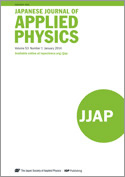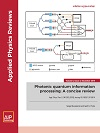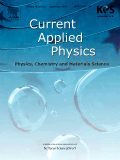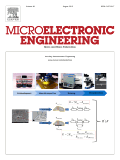
ACS Applied Electronic Materials
Scope & Guideline
Elevating the Standards of Materials Chemistry
Introduction
Aims and Scopes
- Electronic Materials Development:
The journal emphasizes the development of novel electronic materials, including semiconductors, dielectrics, and conductors, and their integration into electronic devices. - Device Fabrication and Characterization:
Research related to the fabrication techniques and characterization methods for electronic devices, including thin-film transistors, photodetectors, and sensors, is a core focus. - Energy Harvesting and Storage:
The journal covers advancements in materials and technologies for energy harvesting devices, such as triboelectric nanogenerators and supercapacitors, highlighting their applications in wearable and flexible electronics. - Sensing Technologies:
Studies on the development of sensors based on novel materials and architectures for various applications, including environmental monitoring and biomedical sensing, are prominently featured. - Nanostructured and 2D Materials:
The journal explores the unique properties and applications of nanostructured materials and 2D materials (like graphene and transition metal dichalcogenides) in electronic and optoelectronic devices. - Integration of Organic and Inorganic Materials:
Research that combines organic and inorganic materials for enhanced device performance, such as organic-inorganic hybrid solar cells and light-emitting diodes, is an important area of publication.
Trending and Emerging
- Flexible and Wearable Electronics:
There is a significant increase in research related to flexible and wearable electronic devices, emphasizing the development of materials and structures that enable comfort and functionality. - Two-Dimensional Materials:
Research on 2D materials, particularly transition metal dichalcogenides and their heterostructures, is gaining traction due to their unique electronic and optoelectronic properties. - Sustainable and Eco-Friendly Materials:
The trend toward sustainability is evident, with a growing number of studies focusing on biodegradable and environmentally friendly materials for electronic applications. - Smart Sensors and IoT Applications:
Emerging research themes include the development of smart sensors for Internet of Things (IoT) applications, leveraging advanced materials for enhanced sensitivity and functionality. - Integration of AI and Machine Learning:
There is a rising interest in the application of artificial intelligence and machine learning techniques in the design and optimization of electronic materials and devices. - Next-Generation Memory Devices:
Research on advanced memory technologies, including memristors and neuromorphic devices, is on the rise, focusing on their potential applications in artificial intelligence and computing.
Declining or Waning
- Traditional Silicon-Based Devices:
Research on conventional silicon-based electronic devices is becoming less prominent as the focus shifts toward alternative materials and novel device architectures. - Conventional Energy Storage Solutions:
Studies centered around traditional battery technologies are declining in favor of more innovative energy storage solutions, such as supercapacitors and hybrid systems. - Passive Components:
Research on passive electronic components, such as resistors and capacitors, has decreased as the field has moved toward active devices and multifunctional materials. - Bulk Materials Characterization:
There is a noticeable decline in studies focused solely on the characterization of bulk materials without direct application to devices, as interest shifts toward nanoscale and interface phenomena. - Legacy Photovoltaic Technologies:
Research on older photovoltaic technologies is waning, with a shift toward innovative materials and hybrid structures that promise higher efficiencies.
Similar Journals

JAPANESE JOURNAL OF APPLIED PHYSICS
Empowering Discoveries in Applied SciencesThe Japanese Journal of Applied Physics is a premier publication in the field of applied physics, offering a platform for researchers and professionals to present their findings and innovations. Published by IOP Publishing Ltd, this esteemed journal has been active since 1963 and continues to contribute significantly to the understanding and advancement of applied physics across diverse applications. The journal is recognized for its rigorous peer-review process and high-quality publications, evidenced by its 2023 ranking of Q2 in Engineering (Miscellaneous) and Q3 in Physics and Astronomy (Miscellaneous). With an accessible ISSN of 0021-4922 and E-ISSN 1347-4065, the journal cultivates a global readership, fostering collaboration and innovation within the scientific community. Although the journal does not currently offer open access options, its valuable insights into the latest technological advancements and theoretical developments remain crucial for students, researchers, and industry professionals alike. By bridging the gap between fundamental physics and practical applications, the Japanese Journal of Applied Physics plays a vital role in shaping the future of applied sciences in Japan and beyond.

Advanced Electronic Materials
Leading the Charge in Materials Science ExplorationAdvanced Electronic Materials is an esteemed journal published by Wiley, dedicated to the forefront of materials science, particularly in the areas of electronic, optical, and magnetic materials. With a commendable impact factor that places it in the Q1 quartile of its category and a Scopus rank of 36 out of 284, the journal is a vital resource for researchers, professionals, and students aiming to contribute to this rapidly evolving field. Launched in 2015 and fully transitioned to Open Access in 2023, the journal promotes widespread dissemination of knowledge, ensuring accessibility to groundbreaking research findings. With its address located in Germany at 111 River St, Hoboken 07030-5774, NJ, it serves a global academic community eager to explore innovative materials technologies that influence diverse applications ranging from consumer electronics to advanced manufacturing. As researchers seek to push the boundaries of what is possible with materials, Advanced Electronic Materials stands as a premier platform for sharing, discovering, and advancing knowledge in this essential domain.

Transactions on Electrical and Electronic Materials
Pioneering Research for Tomorrow's TechnologyTransactions on Electrical and Electronic Materials, published by Springer, is a distinguished journal aimed at advancing the fields of electrical and electronic engineering, as well as electronic, optical, and magnetic materials. With an ISSN of 1229-7607 and an E-ISSN of 2092-7592, this journal is vital in disseminating impactful research and innovations, providing insights and significant findings that cater to both academia and industry. Holding a Q3 ranking in the categories of Electrical and Electronic Engineering and Electronic, Optical and Magnetic Materials, it serves as a reputable platform for sharing research that influences ongoing developments in these critical areas. The journal's converged years from 2011 to 2024 signify its commitment to providing a comprehensive review of technological advancements. Located in New York City, it appeals to a global audience of researchers, professionals, and students, enhancing their understanding of current trends and practices within the domain.

Applied Physics Reviews
Bridging Theory and Experiment in PhysicsApplied Physics Reviews, published by AIP Publishing, is a premier journal prominently positioned in the field of physics and astronomy. With an impressive impact factor that reflects its significance, this journal ranks in the 1st quartile (Q1) in 2023 and holds the 9th position out of 243 journals in General Physics and Astronomy according to Scopus, placing it in the 96th percentile of its category. Established as a vital platform for the dissemination of groundbreaking research and reviews, Applied Physics Reviews aims to bridge theoretical and experimental studies, enabling a comprehensive understanding of applied physics advancements. Although not open access, the journal provides a rich resource for researchers, professionals, and students keen on exploring the latest developments and trends within applied physics, offering insights that are crucial for both academic and industrial applications. With a converged timeline from 2014 to 2024, this journal continues to foster significant contributions to the field and encourages a collaborative dialogue among scholars and practitioners.

CURRENT APPLIED PHYSICS
Connecting Ideas, Driving Discoveries in Applied Physics.Current Applied Physics is a leading journal published by Elsevier, specializing in the dynamic fields of Physics and Materials Science. With an ISSN of 1567-1739 and an E-ISSN of 1878-1675, this journal focuses on the latest advancements and applications of physics principles in various practical domains. Operating from the innovative hub of Amsterdam, Netherlands, Current Applied Physics occupies a significant niche in the scientific community, evidenced by its Q2 ranking in both the Physics and Astronomy and Materials Science categories for the year 2023, along with impressive Scopus rankings that highlight its relevance in the fields of General Physics and General Materials Science. The journal's scope encompasses a wide range of topics, fostering interdisciplinary collaboration and facilitating the exchange of knowledge among researchers, professionals, and students. Each issue features peer-reviewed articles that contribute to the understanding and application of physical sciences, making it an essential resource for those aiming to stay at the forefront of research and innovation in applied physics.

MICROELECTRONIC ENGINEERING
Fostering Collaboration in Cutting-Edge Research and DevelopmentMICROELECTRONIC ENGINEERING is an esteemed journal published by Elsevier, focusing on the rapidly evolving fields of microelectronics and nanotechnology. It encompasses a wide array of topics, including atomic and molecular physics, condensed matter physics, and the engineering aspects of electronic, optical, and magnetic materials. With its impressive impact factor and recognition as a Q2 journal in several categories, it provides an invaluable platform for researchers and professionals to disseminate their groundbreaking findings. The journal has been instrumental in advancing our understanding and application of microelectronic technologies since its inception in 1983. Currently ranked highly within various specialized categories in Scopus, MICROELECTRONIC ENGINEERING offers targeted access to cutting-edge research, fostering innovation and collaboration in the world of electronic engineering and materials science. As we look towards the future, with convergence continuing to shape research until 2024, the journal remains a critical resource for those dedicated to pushing the boundaries of knowledge in these dynamic fields.

Journal of Nanoelectronics and Optoelectronics
Driving Discoveries in Cutting-edge Optoelectronic DevicesJournal of Nanoelectronics and Optoelectronics is a premier peer-reviewed journal published by AMER SCIENTIFIC PUBLISHERS that showcases cutting-edge research in the fields of electrical engineering, nanoelectronics, and optoelectronic materials. Established in 2006 and spanning through to 2017, this journal provides a platform for scientists and engineers to share their latest findings, developments, and innovations. Although coverage has been discontinued in Scopus, it retains an regional impact within its field, ranking #388 out of 654 in Electrical and Electronic Engineering and #156 out of 219 in Electronic, Optical, and Magnetic Materials. The journal is crucial for those seeking to advance their knowledge in nanoscale electronic components and optoelectronic devices, making it an essential resource for researchers, professionals, and students committed to this dynamic area of study. While the journal is not open access, it remains a significant contributor to the scholarly discourse surrounding next-generation electronic technologies and materials.

PHYSICA STATUS SOLIDI A-APPLICATIONS AND MATERIALS SCIENCE
Shaping the future of engineering and materials research.PHYSICA STATUS SOLIDI A-APPLICATIONS AND MATERIALS SCIENCE, published by WILEY-V C H VERLAG GMBH, stands as a prominent journal in the fields of condensed matter physics, materials science, and engineering. With an ISSN of 1862-6300 and E-ISSN 1862-6319, this journal has been actively contributing to scientific discourse since its inception. The journal currently holds a respectable Q2 ranking across several categories including Electrical and Electronic Engineering and Materials Chemistry, demonstrating its significance in advancing research and development within these domains. Although it does not offer open access, the journal ensures high-quality peer-reviewed content that is critical for researchers and professionals aiming to stay at the forefront of materials science innovations. The journal’s convergence years, extending from 2005 to 2024, reflects its ongoing commitment to publishing impactful research. By facilitating discussions on applications and advances in materials science, PHYSICA STATUS SOLIDI A continues to be an essential resource for those striving to contribute to this dynamic field.

SEMICONDUCTOR SCIENCE AND TECHNOLOGY
Exploring the forefront of materials science and engineering.Semiconductor Science and Technology is a pivotal journal in the fields of condensed matter physics, electrical and electronic engineering, and materials science, published by IOP Publishing Ltd. With an ISSN of 0268-1242 and an E-ISSN of 1361-6641, this esteemed journal has been disseminating groundbreaking research since 1986 and is set to continue through 2024. Recognized in the latest categorizations, it holds a notable Q2 ranking in Condensed Matter Physics, Electrical and Electronic Engineering, and Materials Chemistry, alongside a Q3 ranking in Electronic, Optical, and Magnetic Materials, highlighting its significant contribution to the advancement of these disciplines. Although it does not operate under an open access model, the journal provides critical access options for researchers and professionals seeking to foster innovation and collaboration within the semiconductor community. As a vital resource, Semiconductor Science and Technology not only supports the dissemination of high-quality research but also serves as a platform for emerging trends and developments that are shaping the future of semiconductor technology.

InfoMat
Connecting Researchers and Practitioners in the Materials DomainInfoMat is a premier open-access journal published by WILEY that serves as a vital resource for scholars and practitioners in the fields of materials science, materials chemistry, and related disciplines. Since its inception in 2019, this journal has rapidly ascended in academic stature, currently holding a prestigious Q1 ranking across multiple categories, including Electronic, Optical and Magnetic Materials, Materials Chemistry, and Surfaces, Coatings and Films, showcasing its significant impact and relevance. With a commendable impact factor and a comprehensive scope, InfoMat provides a platform for high-quality research that drives innovation in the materials domain, appealing to researchers, professionals, and students alike. The journal’s open-access model enhances visibility and accessibility of cutting-edge studies, fostering a collaborative and informed scientific community. Based in the United Kingdom, InfoMat continues to shape the future of materials research through its commitment to excellence and accessibility.